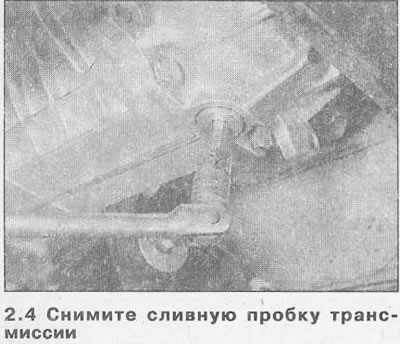Note: Manufacturers use three different types of manual transmission oil. Because different types of oil must not be mixed, it is critical to fill the block with the same type of oil as the drained one or with the latest variety of oil (used in production since 1999). If the type of oil drained is not known, fill the block with the latest oil 19 40 768 until the level rises to the bottom of the filler hole, then install the plug. Drive the car for approximately 20 km, then drain the oil and refill the transmission with a fresh batch of the same oil.
Oil drain
1. To make this operation faster and easier, warm up the engine/transmission to normal operating temperature with a short drive.
2.Park the car on level ground (not slanted), turn off the ignition and apply the handbrake. To improve access, jack up the front of the vehicle and place it securely on axle stands. Please note that when filling the block and measuring the oil level, the vehicle must be on its wheels to ensure accuracy.
3. Clean off any dirt, then unscrew the fill plug located on the right side of the transmission case.
4. Place a suitable container under the drain plug located on the base of the transmission case, then unscrew the plug and allow the oil to drain into the container (see illustration). Clean the fill and drain plugs, taking care to remove any metal particles from the magnetic inserts.

Attention! If the oil is hot, beware of splashing.
5. When all the oil has drained out, clean the drain plug threads and the transmission case holes, then install the plug and tighten it to the specified torque.
Block filling
6. Filling the transmission is extremely inconvenient. In addition, in order for the oil level to settle (before it can be measured) it takes a lot of time. Please note that the car must be on a level surface.
7. Fill the transmission with the required type and amount of oil, then check its level as described in points 12 and 13. When finished, install the filler plug and tighten it with the tightening torque specified in the Specifications.
8. Drive a short drive to distribute the new oil around the transmission components.
9. Upon returning, park the car on level ground (not slanted) and check the oil level again.
Examination
Note: When adding oil to the transmission, use the same amount that the block was filled with. These models use three different types of oil and should not be mixed (see Note given at the beginning of this Chapter).
10. Install the car over a viewing hole or on a flyover. The oil level should be checked at least 5 minutes after the engine has been turned off.
11. Wipe the area around the filler plug located on the right side of the transmission case. Unscrew the plug and clean it.
12. To check the oil level, you need to make a dipstick (for example, from a piece of welding electrode, bending one end at a right angle). Insert a dipstick into the filler hole and measure the oil level - it should be approximately 9mm below the inside edge of the filler plug opening.
Attention! When checking the oil level, be very careful not to drop the dipstick into the transmission unit.
13. If necessary, top up the oil level.
Note: Do not overfill the transmission, this will make shifting difficult. If necessary, drain or pump out excess oil from the block.
14. Upon completion, install the filler plug and tighten it with a tightening torque regulated specifications.

Visitor comments